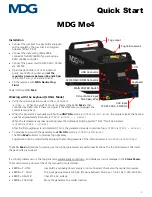
Installation / Initial operation
16
system (see Figure 3.1/2). The following assignment applies: Hose 1 to connection
(10), Hose 2 to connection (9).
3. Turn the tank system on. Wait until the hose has reached a temperature of approx.
100 °C. The display at the front of the unit helps to track the temperature.
4. Now screw on the cap nut of the hose by hand onto the corresponding connection of
the tank system (see (12) in Figure 3.1/2).
5. Secure the connection at the tank system with an open-end wrench (size 19).
Using the other open-end wrench, tighten the cap nut of the hose.
6. If one of the connections will not be used, then it must be securely sealed with a blind
plug.
4.2
First commissioning
Perform the following work steps for first commissioning:
1. Make sure that the system has been correctly connected to a protective conductor
outlet.
2. Make sure that the hose connections, or the blind plug, are screwed securely.
3. Open the tank cover and fill the desired hot melt adhesive into the tank. Fill up the
tank up to maximally 25 mm below the upper edge of the tank.
4. Turn on the main switch. The unit will now begin with the warming up procedure.
Depending on the working temperature set and the amount of hot melt adhesive
filled, the warming up procedure may last up to half an hour. The temperatures of the
tank, hose, and manual application unit can be monitored in the display.
5. As soon as the working temperature has been reached, the “Temperature reached”
control lamp lights up.
6. Now turn on the pump drive.
7. Hold the nozzle of the manual application unit over a piece of cardboard or similar un-
derlay. Continue activating the trigger until a continuous stream of hot melt adhesive
is discharged from the nozzle.
8. After manufacture, the unit was subjected to a function test. Hot melt adhesive was
filled during this test, and the residue must be removed before first use. Continue
activating the trigger until only the hot melt adhesive that you filled in is discharged
from the nozzle.
9. This concludes the first commissioning. The tank system can now be programmed
and utilized.
0
I
0
I
Summary of Contents for HB 5010
Page 10: ...2...
Page 14: ...Special security advice 6...
Page 16: ...Technical data 8 Figure 2 1 2 Location of type plate on the inside of the unit...
Page 28: ...Operation 20...
Page 40: ...Operation 32...
Page 57: ...Repairs 49...
Page 60: ......
Page 62: ...Table of Contents 4 Table of contents...
Page 64: ...Specific security advice 6...
Page 68: ...Technical Data 10...
Page 76: ...Maintenance 18...
Page 80: ......
Page 82: ...4 Inhaltsverzeichnis...
Page 84: ...Specific safety instructions 6...
Page 90: ...Construction and function 12...
Page 92: ...Technical data 14...
Page 104: ...What happens if 26...
Page 107: ...Accessories 29...
Page 110: ...Ersatzteillisten...
Page 115: ...Spare parts list 3 1 HB 5010 Tank System basic unit Fig 1 1 Spare parts for basic unit Part 1...
Page 128: ...Spare parts list 16 2 3 Spare parts bead and spray 19 9 Fig 2 11 Grip casing both versions...
Page 129: ...Spare parts list 17 11 Fig 2 12 Heat insulation half shell both versions...
Page 130: ...18 Spare parts list 10 Fig 2 13 Trigger and mounting parts both versions...
Page 133: ...Table of contents 21...
Page 136: ...Table of Contents 2...
Page 138: ...4...
















































